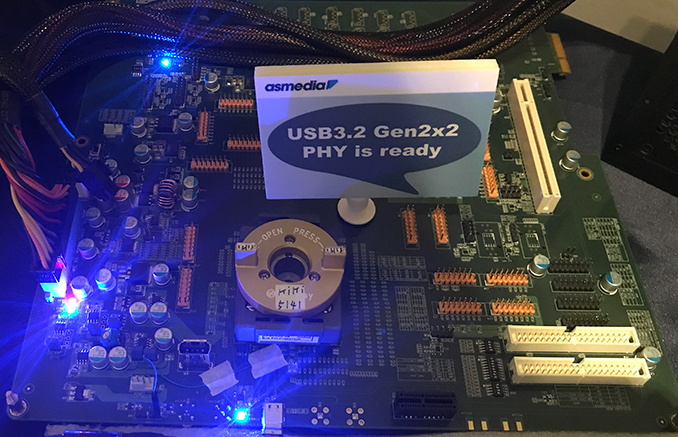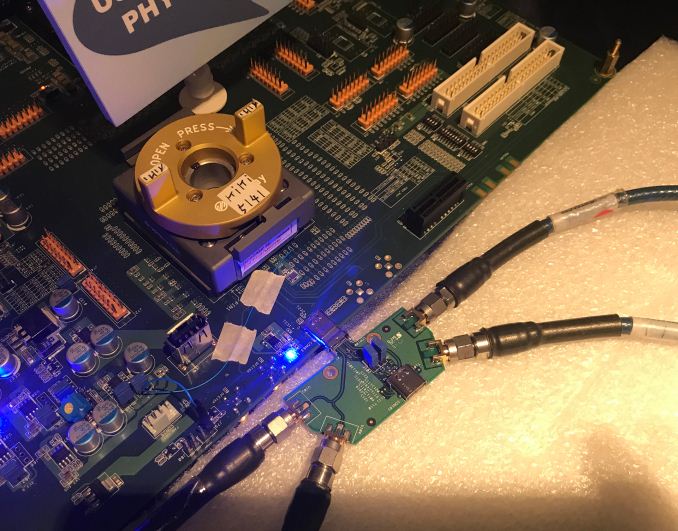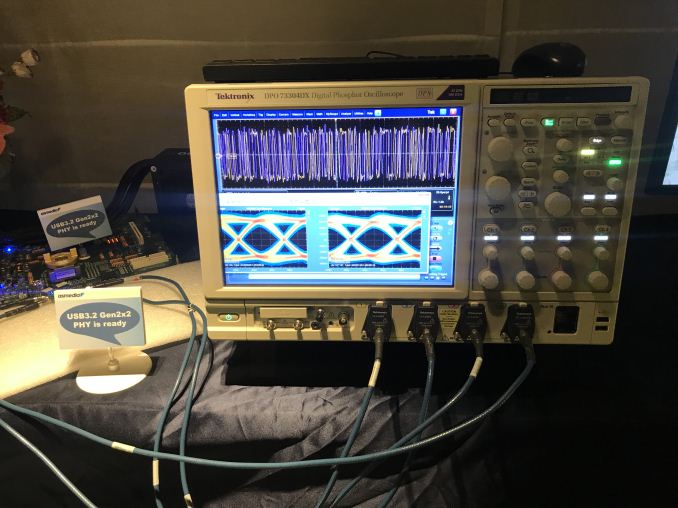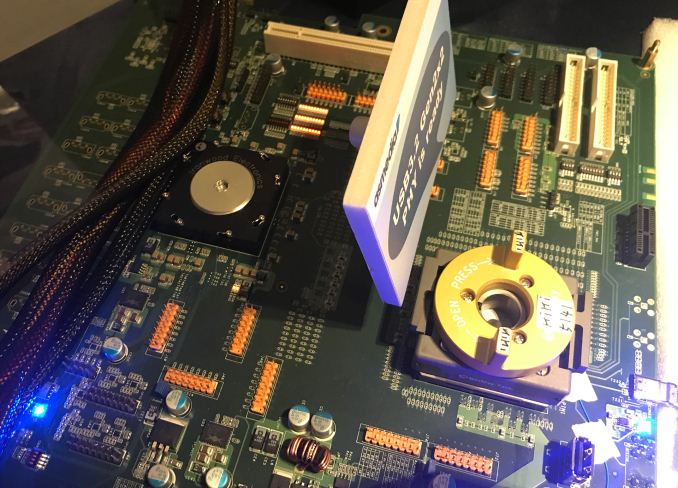ASMedia Demos USB 3.2 Gen 2x2 PHY, USB 3.2 Controller Due in 2019
by Anton Shilov on June 7, 2018 12:00 PM EST- Posted in
- USB
- Trade Shows
- USB-C
- ASMedia
- USB 3.2
- Computex 2018

USB IF published the final USB 3.2 specification in September last year and so developers of controllers and physical interfaces (PHY) started to design their solutions supporting the new tech. As it appears, the development process is proceeding well at ASMedia, which is demonstrating its USB 3.2 PHY at Computex.
The USB 3.2 uses two high-speed USB Type-C Tx/Rx channels to achieve 20 Gbps maximum throughput and while the technology retains the USB 3.1 physical layer data rates and encoding techniques, it still needs a new PHY to work. Just several days ago Synopsys demonstrated its USB 3.2 prototype solution, and apparently, ASMedia also has its USB 3.2 PHY ready. The company does not disclose which process technology it uses for the physical interface, but 10 Gbps data transfer rate is not something that has serious requirements.
Based on the oscilloscope readings, ASMedia’s PHY works nearly ideally, so the next step for the company is building a USB 3.2 Gen 2x2 controller featuring this physical interface.
ASMedia says that its controller will be ready in 2019, but does not specify when exactly. Keeping in mind that it takes some time for actual hardware makers to adopt new controllers, do not expect USB 3.2 devices to hit the market earlier than in 2020.
| Want to keep up to date with all of our Computex 2018 Coverage? | ||||||
 Laptops |
 Hardware |
 Chips |
||||
| Follow AnandTech's breaking news here! | ||||||













12 Comments
View All Comments
iwod - Thursday, June 7, 2018 - link
Does any one knows why the USB 1.1 / 2.0 pin can not be used for USB 3.0 / 3.2 protocol? Assuming we put a chip to signal both end are compatible? We end up having USB Type-C and we are only using 4 Set of pins for 20Gbps.stuffwhy - Thursday, June 7, 2018 - link
Best guess is that they have to leave room for devices transmitting over USB 2.0 as well as USB 3.2, perhaps in the case of a hub or dock.edzieba - Thursday, June 7, 2018 - link
Due to the requirement to always maintain a USB 2.0 channel for all possible Type C versions for the purpose of protocol identification. "Just stick some resistors between two pins" doesn't cut it when you're dealing with a large number of different possible high-speed protocols and also want to transport high-wattage power (so sticking a resistor between the power rails would be a Bad Idea).voicequal - Saturday, June 9, 2018 - link
In the case of USB 3.0 cables, there are only two pairs that are individually shielded for high speed signalling. The USB 2.0 wire pair is not individually shielded indicating it doesn't support the required signal integrity for USB 3.0 data rates. I haven't looked at a USB-C cable, but likely only four pairs are designed for high speed signalling.brunis.dk - Thursday, June 7, 2018 - link
"but 10 Gbps data transfer rate is not something that has serious requirements." aha? that's why we are still strugling to get 10Gbps net on motherboards and just invented intermediate 2.5/5Gbps tech to ease the transition. Glad to hear it's so effortless.The_Assimilator - Thursday, June 7, 2018 - link
Because 10Gbit over 1 meter is identical to 10Gbit over a hundred... moron.Death666Angel - Thursday, June 7, 2018 - link
The 10Gb/s network will give you those speeds for dozens of meters. USB can have issues at 1m, 2m cables are difficult to get decent quality and above that it just gets more expensive and trial-and-error-y in my experience. Also, the tech behind 10Gb/s has been around for over 10 years and some equiment is even quite affordable these days. You can buy a PCIe 10Gb/s network card for less than 200€. It's mostly an issue of demand/need. No one in my circle even uses their wired LAN connection for anything except to connect to their 20Mbit/s internet connection. Even 1Gb/s would be plenty for those people. Officed and workstations might need more, but they already have the tech. No need to increase the BOM of a normal H or B chipset board. Or even most Z and X ones for the gamers and overclockers.tomatotree - Thursday, June 7, 2018 - link
You're taking that out of context. The comment was about process technology. What they're saying is that it doesn't matter if the chip was made on 7nm, 14nm, 22nm, etc because any of those manufacturing nodes are capable of 10Gbps easily. It says nothing whatsoever about if it's cost effective to put it on a consumer motherboard.HStewart - Thursday, June 7, 2018 - link
So in theory if they can find a way to handle 4 connections they could have the speed of Thunderbolt 3 - and don't say it because of connector - because the connector thunderbolt 3 is compatible with USB C.I don't like this coming from ASMedia, they have a history of security issues and possibly other problems.
repoman27 - Friday, June 8, 2018 - link
No. In reality, USB 3.2 is similar to Thunderbolt 2—a bonded pair of 10 Gbit/s, full-duplex channels. When USB moves to 20 Gbit/s per channel it will have the speed of Thunderbolt 3. Four channels isn't in the cards as it would require all new connectors and cables and significantly increase cost and cable size.USB Type-C cables and connectors support four high-speed differential signaling pairs, enough for two full-duplex channels. USB 3.1 10Gbps only uses two of the pairs. The other two are there to simplify things due to the fact that the connector can be inserted in either orientation, or for use by alternate modes such as DisplayPort or Thunderbolt. USB 3.2 20Gbps still uses 10 Gbit/s signaling, but leverages all four pairs and implements channel-bonding.